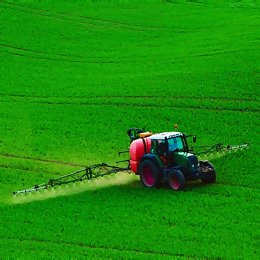
Contrary to the doom and gloom reported about declining equipment sales in the agricultural sector, DLL’s Ken Whitelaw, Vice President of Sales and Program Management for DLL’s Food & Agriculture Business Unit sees greener pastures for the sector. In this exclusive Q&A interview, Equipment Finance Advisor spends time with Whitelaw to learn where opportunities for growth are developing in the agricultural equipment finance sector, and the influencers of this growth.
Equipment Finance Advisor: According to a recent report issued by the Association of Equipment Manufacturers, U.S. retail sales of 2WD and 4WD tractors and combines continue to track higher than 2015 levels with strong under 40HP sales offsetting significant declines in the larger production equipment. This report is in sharp contrast to the many reports describing declining demand for agricultural equipment. What major factors are impacting this positive growth in demand for smaller agricultural equipment?

Ken Whitelaw: This divergence can best be explained by looking at the criteria different agricultural customers use to make buying decisions.
Smaller tractors are generally purchased by hobby farmers whose buying decisions are directly tied to the economic environment, with employment and housing starts being important criteria. The purchasing decisions of row crop production customers, on the other hand, are largely based on their net cash flow projections, which are directly tied to crop prices minus the cost of inputs like seed and fertilizer. Hobby farmers typically have a primary source of income outside of farming, so the recent improvement in the U.S. economic environment has contributed to the continued growth of under 40HP tractor sales. As long as the U.S. economic environment remains reasonably positive, the sale of smaller tractors is likely to remain buoyant regardless of the demand for larger production equipment.
The under 40HP market has also benefited from demographic trends. As the Baby Boomer generation retires, many individuals are moving to more rural areas. This has subsequently led to an increase in the number of small farms in the U.S. In 2002, the U.S. Department of Agriculture (USDA) counted 743,118 farms ranging in size from one to 49 acres. By 2012, the number grew to 813,183. The fact that the number of potential customers for under 40HP tractors has increased over the last fifteen years further explains the improved sales results.
Equipment Finance Advisor: Various data shows an increase in consumer demand for locally harvested crops. Additionally, consumer demand for organically grown products is continually growing. How will these factors impact equipment demand for smaller acreage farmers and livestock providers in the coming years?
Whitelaw: As consumers continue to request more local and organic products, the number of small farms (less than 49 acres) will increase to meet the demand.
Manufacturers, dealers and their financing partners will need to understand the requirements of this customer segment in order to be successful. These smaller farms will purchase lower horsepower tractors and related attachments and will likely keep this equipment for longer periods of time. They will be focused on affordability, so financing that offers that target market a competitive monthly payment will be key for growing equipment sales. These customers are also likely to purchase equipment based on functionality and intended use rather than brand recognition. We believe this market has significant long-term growth potential.
Equipment Finance Advisor: Vendor finance programs require consistent and close attention in order to meet the changing financing needs of end-users. With this in mind, what changes have you seen in the types of financing required to help vendors sell more equipment? Has the growing equipment rental market impacted equipment sales demand?
Whitelaw: The agricultural equipment financing market has evolved considerably over time and is more sophisticated and customized than ever before.
In the production agriculture market, we have seen increased requests for creative options to encourage sales in this somewhat challenging environment. In particular, the operating lease product is a much more prevalent financing tool than in prior years. Larger, more corporate farming operations tend to value newer equipment that is covered under factory warranty and are typically less motivated by long-term ownership. In addition, these customers are focused on cost of usage (e.g., cost per acre farmed) and therefore appreciate the lowest possible annual payment, which is usually available under a lease product. In certain instances, customers are also looking to include the cost of service as part of their lease financing package to ensure there is a full understanding of total cost of ownership. DLL believes leasing will continue to become an increasingly popular way for manufacturers and dealers to sell more equipment.
In the hobby farmer market, we have seen requests for new technologies that will enhance service delivery. Dealers and end-users in this market require prompt and accurate responses to credit requests and want the ability to close transactions on demand, so online applications and auto-decision functionality are essential. That said, dealers also need the ability to talk with a knowledgeable financing partner if, for whatever reason, a revised structure is required to proceed with a particular sale. Financing is a key part of the sales process for dealers in this market, and they are focused on closing deals as efficiently as possible. Loans generally remain the dominant form of financing in this market, though operating leases may ultimately be more readily available in the future.
The rental market has grown and some dealers have successfully implemented rental strategies in their respective markets. In certain instances, captive finance companies have provided short-term rental facilities to enhance the sale of production agriculture equipment. This will remain a key part of the industry, but should be managed carefully in this current environment as important decisions need to be made regarding the remarketing of equipment after the rental period.
Equipment Finance Advisor: What is DLL’s overall outlook for the North American agricultural market? More specifically, how will low commodity prices and growing used equipment inventories impact the sales of equipment –- for both small and large farmers?
Whitelaw: DLL’s overall view of the production agriculture market is one of long-term optimism yet short-term caution. We do not foresee any material change in the current market dynamic with low commodity prices –- and the corresponding negative impact to farmers’ cash flows –- projected for 2017 and likely 2018.
The USDA forecasts Net Farm Income to be approximately $54.8 billion in 2016, representing a 56% decline from the peak of the market in 2013. However, this year’s forecast is similar to what was reported during 2006 through 2010. So when viewed over a longer term horizon, this decline should be manageable for the majority of farmers.
In addition, farmers are generally not overleveraged. The debt-to-asset ratio for farmers is forecast to increase to 13.2% in 2016 compared to the historical low of 11.3% in 2012, but it’s still not close to the 22.5% ratio reported during the last farm crisis in 1985.
The production agricultural market will be challenged during the next couple of years with potentially lower new business volume and higher delinquencies, but these will be manageable situations. In the long term, we foresee a relatively positive market as customers will ultimately require new equipment as well as creative financing solutions to support their purchases.
For the previously mentioned reasons, we are even more positive about the hobby farmer market. Due to both macroeconomic and demographic reasons, we think this market will continue to grow and will represent the most positive segment of our industry over the next few years.